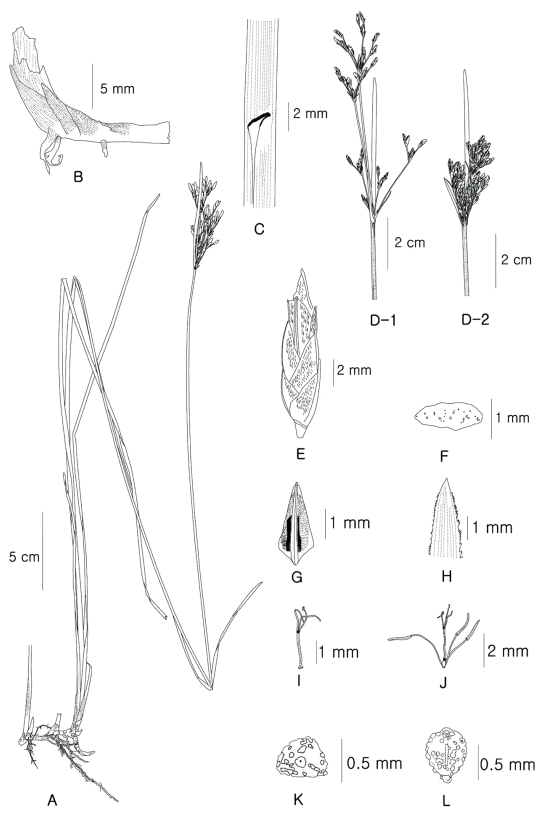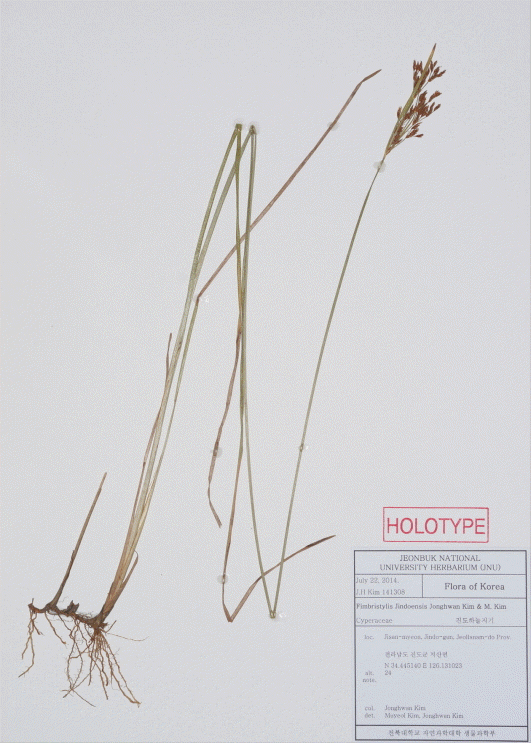The genus Fimbristylis Vahl (Cyperaceae) consists of approximately 200−300 species and is distributed primarily in tropic, subtropic, and temperate zones of the Northern Hemisphere (Ohwi, 1944; Kral, 1971; Kern, 1974; Ball et al., 2002; Zhang et al., 2010).
Fimbristylis species are generally characterized by the presence of leaf blades, leaf sheaths without long silk hairs at the apex, and nutlets without persistent style bases (Kim and Kim, 2013, 2015). Twenty Fimbristylis taxa are found in Korea (Lee, 1980; Lee, 1996; Im, 2000; Lee, 2006; Oh, 2007). Of these, F. dichotoma (L.) Vahl and F. autumnalis (L.) Roemer & Schultes are widely distributed, while F. hookeriana Boeckeler and F. pierotii Miq. are rarer and more sporadically distributed (Oh, 1991; Oh and Park, 1997; Kim and Kim, 2013).
A new species of F. jindoensis was discovered for the first time at wet lowland mountain slopes, Jindo-gun, Jeollanam-do Province, Korea. The new species shares several characteristics (long creeping rhizomes, oblong spikelets, brown scales, and 3-sided achenes) with a related species, F. pierotii Miq., but it was distinguished by 57−93 cm tall culms, flowers in July to August, a wet mountain habitat, more than 20 spikelets, and compound anthela inflorescences. Thus, we named this new taxon as Fimbristylis jindoensis J. Kim & M. Kim.
Taxonomic Treatment
TYPE: Jisan-myeon, Jindo-gun, Jeollanam-do Province, Korea. 22 July 2014. J. H. Kim 141308 (Holotype, JNU; Isotypes, JNU. KH); Imhoe-myeon, Jindo-gun, Jeollanam-do. 22 July 2014. J. H. Kim 141288 (Paratype, JNU).
Korean name: 진도하늘지기(Jin-do-ha-neul-ji-gi)
Perennials. Rhizomes 1.5−2.5 mm diam., long-creeping, covered with ovate brown scales. Culms solitary, 57−93 cm tall, 1.7−3.2 mm diam, compressed oval, 3−5 striate, glabrous, apically scabrid, with 3−5 leaves at base. Ligule very short, ciliate. Leaves shorter than culm, leaf blade 7− 51 cm long, 1−3 mm wide, flat, upper margin finely serrulate, apex acute. Involucral bracts 2−4, 1.7−10.2 cm long, suberect, setaceous to leaves, much shorter than inflorescence, sometimes longer than inflorescence, base dilated, margin finely serrulate. Inflorescence compound anthela with more than 20 spikelets, 2.2−8.0 cm long, 1.1−4.5 cm wide, rays 3− 11, 0.8−5.7 cm long, slightly striate. Spikelets 5−15 flowered whirl, solitary, oblong or narrowly ovoid, 4.2−7.2 mm long, 1.2−1.7 mm wide, apex acute. Scales broadly ovate, pale brown to yellowish brown, 2.8−3.6 mm long, 2.0−2.9 mm wide, margin hyaline, strongly folded by a 3-veined keel, veins yellowish green projecting into a acute. Stamens 3, anthers yellow, 1.8−2.3 mm long. Style not ciliate, 3-angled. 1.6−1.8 mm long, stigmas 3, 0.9−1.5 mm long. Achene white or yellowish white, obovoid 3-sided, 0.7−0.9 mm long, 0.5− 0.6 mm wide, with sparsely verruculose. Flowering and fruiting July to August.
Distribution: Southern Korea (Jindo-gun, Jeollanam-do).
Etymology: The specific epithet was derived from the type locality, Jindo island, Korea.
Habitat: This new species grows on wet lowland mountain slopes in Southern Korea.
Flowering and Fruiting: July to August
Notes: The new species, F. jindoensis J. Kim & M. Kim, closely resembles F. pierotii as it has long-creeping rhizomes, but is distinguished by its wet lowland habitat, July to August flowering period, and compound anthela inflorescences. Its inflorescence are similar to those of F. complanata var. exaltata (T. Koyama) Y. C. Tang ex S. R. Zhang and T. Koyama, but it is distinguishable from that species having short rhizome, 13−48 cm tall culms, and flowers in August to October.
Using the IUCN Red List Categories and Criteria (IUCN, 2011), F. jindoensis is categorized as endangered (EN) species because of its small population located only on wet lowland mountain slopes.
Key to Fimbristylis jindoensis and its related taxa.
1. Spikelets very narrowly ovoid to linear ·································································· F. hookeriana. 바위하늘지기
1. Spikelets ovoid, oblong, narrowly oblong and ovoid-ellipsoid.
2. Inflorescences 1 spikelet ··· F. subbispicata 꼴하늘지기
2. Inflorescences 2 or more spikelets.
3. Achene terete, cross section circle ············································································· F. stauntonii 밭하늘지기
3. Achene obovoid 3-sided, cross section biconvex or 3-sided.
4. Style compressed and ciliate, stigmas 2.
5. Style base with long hairs ·················································································· F. squarrosa 민하늘지기
5. Style base glabrous.
6. Scale less than 1.5 mm ················································································ F. aestivalis 좀민하늘지기
6. Scale longer than 2 mm.
7. Leaf blade folded, achene sub-smooth ························································ F. sieboldii 갯하늘지기
7. Leaf blade flat, achene with reticulation.
8. Spikelet narrowly oblong, achene with hexagonal reticulation ·············· F. longispica 큰하늘지기
8. Spikelet ovoid, ellipsoid, achene with transversely oblong reticulation ···· F. dichotoma 하늘지기
4. Style 3-sided and not ciliate, stigmas 3 or 2.
9. Rhizomes absent, flowering August to October.
10. Annuals, leaf blade compressed ······························································· F. littoralis 바람하늘지기
10. Perennials, leaf blade flat.
11. Spikelet fewer than 20 flower, scale longer than 2 mm··············· F. complanata var. exaltata 어른지기
11. Spikelet more than 30 flower, scale less than 1.5 mm.
12. Stamen 2, scale blackish brown, spikelet ovate························· F. diphylloides 검정하늘지기
12. Stamen 1 (rarely 2), scale straw-yellow, spikelet ovated oval ·················· F. drizae 물하늘지기
9. Rhizomes creeping, flowering May to August.
13. Culms 5−6 furrowed circle and 9−48 cm tall, flowering June to July. fewer than 10 spikelet. simple anthela, sunny dry habitat. ·································································· F. pierotii 들하늘지기
13. Culms shallow furrowed oval and 57−93 cm tall, flowering July to August, more than 20 spikelets, compound anthela, wet lowland habitat. ············································· F. jindoensis 진도하늘지기














